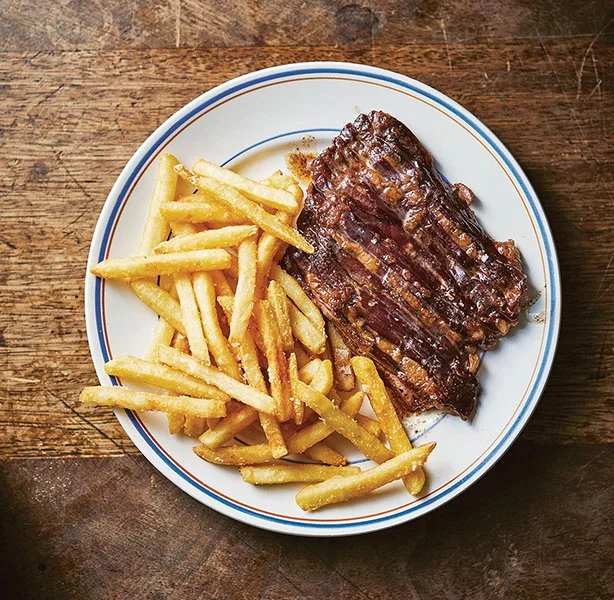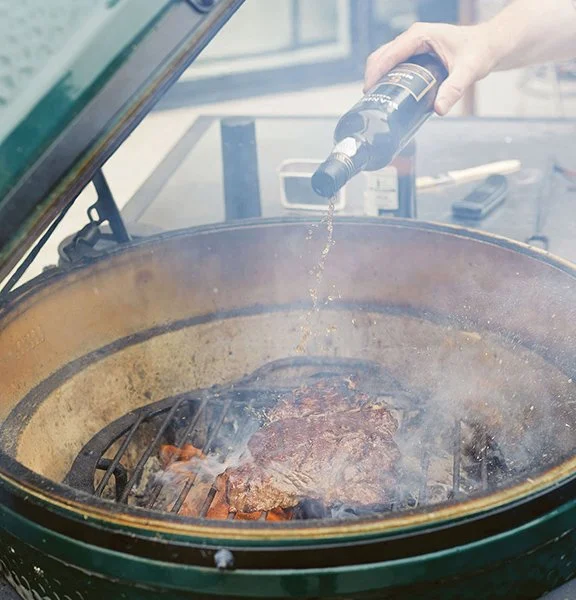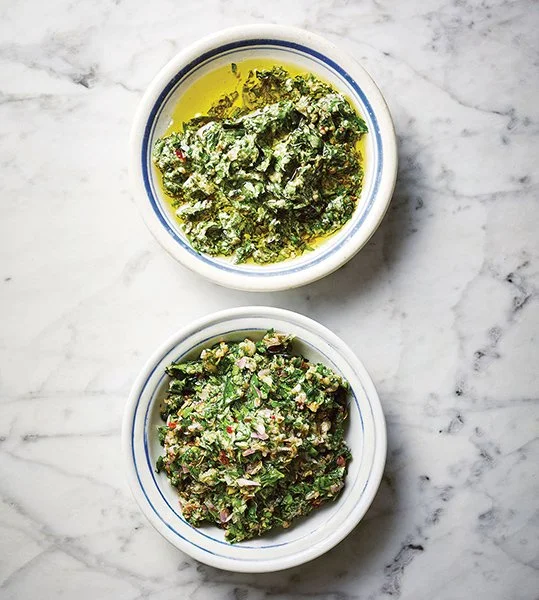
Man’s First Meal
We have been cooking steak over fire since humans first walked the earth. That is some culinary, social and cultural history to digest, but Tim Hayward has written the whole story – the bible for steak lovers.
When I started researching a book on steak, I wanted to be as comprehensive as I could and spent a couple of years in deep research. There were a lot of things that surprised me but the most affecting was how long man, fire and steak have co-existed. So much so, that cooking steak over fire might well be considered the oldest surviving human practice – that’s unless you spend a lot of time napping flint spearheads or making coil pots out of mud.
Aurochs lived in small groups. They were herbivorous ruminants, but that’s about where the resemblance to their descendant, the modern cow, ends. These things must have looked like a cross between a Spanish fighting bull, a water buffalo and an armoured personnel carrier.
They were armed to see off any predator, with a 2m span of horns, and they were as mean as hell. They would live well away from any human encampment, which meant that to kill an aurochs to feed your family group you had to get a bunch of people together, walk for days to track them and then, hope that one was sick, old, slow or stupid. No one ran at a healthy aurochs with a pointy stick and lived to eat steak. In fact, archaeological evidence indicates that the favoured trick was to stampede a few of them off a cliff.
Cave dwellers hunting has been the stuff of many a thrilling movie, but nobody ever considers how they got the meat back to the family. Imagine. You and your mates, a five-day march from home, standing at the bottom of the cliff and staring at a ton and a half of hot meat, leather and bones. The hunters would butcher the carcass on the spot. They’d usually eat the offal – the stuff that would spoil quickly – to give them energy for the hike back. They’d cut out the huge, high protein muscle straps along the creature’s spine and they’d leave the rest for the scavengers they’d already been fighting off for hours.
The loins and sirloins are the highest value concentration of nutrition on the animal. Because bacterial decomposition needs air, it’s only the surface of these great meaty pieces that begins to degrade over the following days. A big, strong hunter could carry an aurochs loin home, maybe hang it in a tree, hopefully somewhere cool, and it might stay in reasonable nick for quite a while. Particularly if, whenever you needed a piece, you just cut a slice off the end. You just cut a steak.
We certainly ate meat this way before we had fire. The great thing about single muscle meat is that it can be eaten raw. We still do as tartare, larb, kitfo, carpaccio and gored gored. And it’s here that we see the historical brilliance of the steak on the grill. Humans tamed fire a long time before they could make pots or vessels, so the first way we cooked steak was to hold it in the flames and hang it in the smoke.
These things kill the surface bacteria, so we must have worked out pretty quickly that putting the meat to the fire meant we all got sick a lot less. But, as anyone who’s ever overcooked a steak will know, there is nothing enjoyable about the meat once it’s cooked through. All the deliciousness remains, as it always has, in that central core of the meat – as rare as we can take it.
One thing that surprises people most is when I say that, despite writing a book about steak, I don’t think there’s a recipe for it. Sure, there are a hundred sauces or serving suggestions.
Pages of tips, tricks and lore about ‘how to cook the perfect steak’, but all those things are just window dressing for a simple process that goes back to a time before we even had speech, let alone wrote cookbooks.
1. Get the best meat you can and season it.
2. Heat the outside as hot and fast as you can.
3. Keep the inside as raw as your taste requires.
So, equipped with a modern outdoor grill, it should be easy. The starting point is still the meat, which, thankfully, you won’t have to hike five days for, drive over a cliff or butcher in the wild. The equivalent, for the modern hunter/gatherer, is to find a brilliant butcher and talk with them about what you want to cook. A butcher will help you choose the meat and cut a steak from it.
Season the steak the night before you mean to cook it. It’s not about flavouring, it’s about drawing out water, concentrating flavours and, because you’ll leave it uncovered in the fridge, it’s about drying out the surface so you can get a better crust faster. You won’t lose the first minutes of thermal energy from the grill making steam and driving it off.
Use something to measure the core temperature accurately as you cook. A regular probe thermometer will do the job, but a MEATER, or similar bluetooth connected probe, is basically the best thing to happen to meat since the flint knife. It gives you a data set that will help you control things. As the only real improvement we’ve achieved in steak cookery since the Neolithic, we’d be mad not to use it.
If I’m cooking individual steaks over fire, I find it’s difficult to beat a ribeye. T-bones require two different cooking times, while sirloins always feel a bit one-dimensional. The ribeye has a built-in fat reserve and is forgiving to cook. Once again, the probe thermometer is essential.
I also believe in constant obsessive flipping. Doing a steak with a single turn gives you flashy grid lines, but flipping has the most astonishing effect. The bottom of the steak is searing at hundreds of degrees, but the minute it’s flipped – when the bottom becomes the top – it cools incredibly fast. Flipping thus slows the rate at which the core temperature rises, while still allowing great browning. It improves your chances of a great steak and hell, who needs grid-lines anyway?
While researching, I got to eat the best steaks all over the world and my two favourites were cooked over fire: the bistecca Fiorentina at Sostanza in Florence, Italy and the Txuleton at Asador Horma Ondo in the hills above Bilbao in Spain.
Both setups were large working areas with an enormous amount of space to vary the heat. The Fiorentina is a T-bone porterhouse which is, by tradition, cut three fingers thick. To cook the centre to a consistent 56.6°C and then to sear the outside crisp requires a range of temperature that’s difficult to replicate on even the largest home rig and requires the experience of a grill jockey that’s been doing the job for decades.
At Sostanza there’s a kind of bench with piles of coals on it. The steak is placed on a small grid iron and shifted obsessively up and down the bench while the cook constantly checks the texture.
At Horma Ondo the range is 6m of grill, fuelled with locally made holm oak charcoal. On a setup like that, you can just take a short walk and find a place to put your txuleton that’s consistently anywhere between about 40°C and 300°C. To give you some idea of the control here, at the cool end they cook custard desserts.
Thick steaks like these will be a challenge on a home grill, but the trick is to find the coolest place you can manage to gently raise the temperature of the meat until the core hits 50°, then shift it to the hottest spot possible and sear hard, hot and short.
I will be completely honest and confess that, when I’m doing a big thick ‘showstopper’ sharing steak, which is embarrassingly often, I put it in a 50°C oven at the beginning of the afternoon then, at dinner time, I crank up the Big Green Egg as far as it will go, and finish the steak off in a couple of minutes with the lid down.
The beauty of the arrangement is that one has complete control over an expensive piece of meat while retaining all the phenomenal flavour advantages of fire cooking. The same ‘reverse sear’ method is now pretty much standard in most steak restaurants. It enables more challenging cuts, like flatirons or large rumps, to be effectively ‘slow cooked’ while remaining medium rare.
Cooking directly on the bars makes any delicate basting very difficult, so it’s tempting to crack out the skillet for the last part of the cook. A lot of butter, some garlic and fresh herbs, spooned and splashed over the meat for the last two turns, is never a bad thing.
Finally, rest. Rest everything, always, and for much longer than you think necessary. Nobody needs to burn their mouth on the outside of a steak.
And, remember, your ancestors would probably have eaten it raw.
Steak: The Whole Story
by Tim Hayward (Quadrille, £30, out now)
Photography @ Sam Folan







